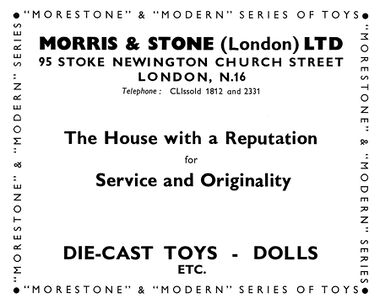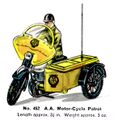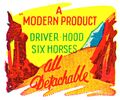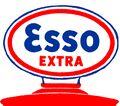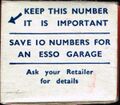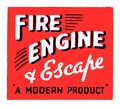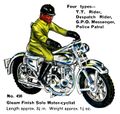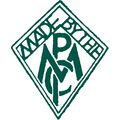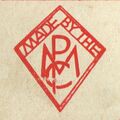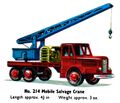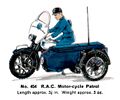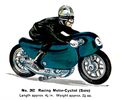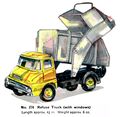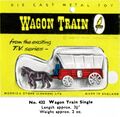Category:Morestone
MORESTONE : Modern Products | ESSO | ESSEM | Mobile | Modern | International | Budgie Miniatures | Budgie Main
| Toy Brands and Manufacturers |
|---|
Morestone |
| 1946 - |
1956: Morestone advert in Games and Toys [image info]
Morris & Stone was founded in around 1946 by Sam Morris, who set up in Stoke Newington, London and started selling toys, drawing on North London's ecosystem of little metal fabrication and diecasting workshops, which were now able to get hold of metal and allowed to manufacture toys (and looking for business opportunities) now that the war was over and life was starting to revert to normal.
North London
The North London ecosystem was partly due to William Britain's presence in the area since the Nineteenth Century, which meant that here were significant numbers of employees and ex-employees who knew something about metalworking and toys, and that this was a viable way to make money. Initially focused more on lead toy manufacturing, the owners of little local businesses learned new technologies during WW2, and the same ecosystem spawned Die Cast Machine Tools (DCMT, Lone Star Toys) in 1939, and Lesney Products (Matchbox Toys) in around 1947, as well as a slew of minor manufacturing and fabrication businesses whose output would tend to flow into the output of larger companies with more established branding and distribution, as subcontractors.
While the classic example of this ecosystem on practice was Horton supplying their 00-scale range to Britains as the Britains Liliput range, many small workshops's work was never properly documented,with the result that, with some of Morestone/Budgie products, we don't actually know who actually manufactured the original castings, or where the tools originated.
1954: In-house manufacturing
Sam Morris originally concentrated on selling the metal toys made by Modern Products (also founded 1946), supplemented with bits and pieces from other local companies, but 1946 gave Morestone the opportunity to finally have their own manufacturing base.
Rodney Smith had originally been a founder of Lesney, along with Leslie Smith (Les-Ney), but after the ambitious Jack O'Dell joined lesney, Rodney seems to have decided that his input wasn't needed as much, and withdrew to start his own diecasting business. This ran into financial trouble in 1954, at which point Sam Morris bought a half share in the business, creating R. Smith (Diecasting) Ltd.
With the success of Lesney's Matchbox range in 1953 showing what could be achieved with proper unified branding, logos and packaging, Morestone began to experiment with unified product ranges.
1956: ESSO Series
The ESSO Series gathered together a range of about twenty disparate models, six made by Modern Products and another ~fourteen made by other "random" suppliers, as a unified product range. Learning from Lesney's gimmick "Matchbox" packaging, where each toy was supplied in a cardboard box that looked like a matchbox, the "ESSO Series" came packaged in cardboard boxes that looked like ESSO petrol pumps. Launching with a range of ten models, the ESSO series created an identity in the minds of toyshops, stood out visually on shelves, and encouraged buyers to keep collecting more models in the series.
1956: Noddy and His Car
1958: International Series: Trucks of the World
"International Series: Trucks of the World" aimed to have the same sort of success with collectors, but was abandoned after three models, presumably eclipsed by Morestone's Big New Idea for a universal range of strongly-branded diecast toy vehicles that could be applied to Morestone's complete output – Budgie Toys!
1959: Budgie Toys
Budgie Toys Launched in 1959. Recognising the psychological importance of giving the impression of having a large and wide range (as shown by Dinky Toys), Morestone initially inflated the apaprent size of the range by starting in the 200's and skipping odd numbers!
Budgie became the default (re/)branding for pretty much everything that Morestone continued to sell.
1961: Guiterman takeover
Recognising that Budgie were now a decent brand, but could do better with proper distribution and marketing, the long-established toy distributor S. Guierman & Co. Ltd bought out Morestone in 1961, and also acquired R.Smith Diecasting. Since the business was now entirely concerned with Budgie, and Morris and the Morris brothers had now left, Guiterman sensibly rebranded their recently acquired company as Budgie Models Ltd. in 1962, and from this point on, references to "Budgie Toys" started to change to "Budgie Models".
Although Budgie Toys was a perfectly fine name for a brand in the UK (Dinky Toys didn't seem to suffer from being referred to as "Toys"), Guiterman may have been thinking ahead in terms of possible exporting to the US, where "Toys" tended to imply playthings for small children, and the word "Models" was less likely to alienate the teenager who wanted to be considered "grown-up"
1966: Guiterman goes bust
S. Guiterman went into voluntary liquidation in 1966, the result of which also took down Budgie Models and R. Smith.
1966: Modern Products take over
Since Modern Products were still making some of the Budgie range, had physical possession of some of the moulds, knew that there were unresourced orders from the States that they could supply, and had almost no other customers apart from Budgie, Modern Products managed to negotiate taking over the Budgie intellectual rights and orderbook, and focused on producing a small range of budgies for the US market.
Alas, the appearance of Mattel's Hot Wheels low-friction cars in 1968 totally disrupted the diecast toy car market and fundamentally changed the business model for toy cars. Given the carnage wreaked by Hot Wheels on even established and successful UK brands like Dinky Toys and Corgi Toys in their home market in the UK, the idea of a small company selling Budgie Toys into Mattell's home market and making a profit was obviously not going to work any longer.
After meetings with UK distributor H. Seener, Budgie essentially became a company making a limited range of diecast London double-decker buses and London taxicabs for the tourist market. Although the "tourist memento" business seemed to be easier than the "proper" toy market, the relationship between Budgie and Seener broke down in the mid-Eighties.
1983: Starcourt
By this time, the company had reached the end of its natural life, and it was decided to close down and sell everything, lock, stock and Barrel, to the company next door, "Starcourt Ltd", who wanted the building to expand into. Having gotten the moulds and brandname and remaining stocks effectively "for free" when they bought the building, Starcourt decided to continue manufacturing Budgies, but the business essentially stopped in around 1985 with the end of the relationship with Seener.
Modern Times
Repro/reissue Budgies are available from https://www.budgiemodels.com/ , who manufacture in the UK, and supply models in copies of the original yellow boxes.
Subcategories
This category has the following 11 subcategories, out of 11 total.
B
- Benbros (2 F)
- Budgie Miniatures (12 F)
E
- ESSEM Series (1 P, 2 F)
- ESSO Series (4 F)
M
- Mobile Vehicle Series (1 F)
N
T
- Trucks of the World (4 F)
Pages in category ‘Morestone’
The following 8 pages are in this category, out of 8 total.
Media in category ‘Morestone’
The following 95 files are in this category, out of 95 total.
- AA Landrover, with windows, Budgie Models 268 (Budgie 1963).jpg 1,637 × 1,089; 316 KB
- AA Mobile Traffic Control Unit, Jumbo, Budgie Toys 218 (Budgie 1961).jpg 1,951 × 1,006; 325 KB
- AA Motor-Cycle Patrol, Budgie Models 452 (Budgie 1963).jpg 1,121 × 1,183; 248 KB
- Air BP Super Fueller, with windows, Budgie Models 280 (Budgie 1963).jpg 2,268 × 749; 333 KB
- Austin Countryman, Budgie Toys 15 (Budgie 1961).jpg 1,708 × 873; 306 KB
- Austin Healey, Budgie Toys 16 (Budgie 1961).jpg 1,431 × 873; 219 KB
- Austin Taxi, Budgie Toys 13 (Budgie 1961).jpg 1,437 × 826; 291 KB
- Bedford LWB Tipper, with windows, Budgie Models 276 (Budgie 1963).jpg 1,652 × 1,106; 321 KB
- Big Ears on his Bicycle, Miniature, No333 (BudgieToys 1961).jpg 1,200 × 1,185; 219 KB
- BR Articulated Van, canvas top, Budgie Toys 240 (Budgie 1961).jpg 1,370 × 869; 248 KB
- BR Articulated Van, hard top, Budgie Toys 238 (Budgie 1961).jpg 1,373 × 1,033; 260 KB
- BR Container Transporter, Budgie Toys 252 (Budgie 1961).jpg 1,527 × 1,087; 304 KB
- BR Locomotive, Budgie Toys 224 (Budgie 1961).jpg 1,488 × 902; 188 KB
- Budgie Breakdown Truck, Budgie Toys 244 (Budgie 1961).jpg 1,424 × 901; 253 KB
- Budgie Gift Set No5 (Hobbies 1966).jpg 1,588 × 1,387; 736 KB
- Budgie logo (1966).jpg 512 × 800; 80 KB
- Budgie Models and Accessories (Hobbies 1966).jpg 1,516 × 2,000; 991 KB
- Budgie Models catalogue (1963).jpg 3,000 × 1,094; 619 KB
- Bulk Flour Tanker, with windows, Budgie Models 288 (Budgie 1963).jpg 1,507 × 988; 314 KB
- Bulk Milk Tanker, with windows, Budgie Models 292 (Budgie 1963).jpg 1,447 × 977; 295 KB
- Cable Drum Transporter, Budgie Toys 232 (Budgie 1961).jpg 1,975 × 815; 297 KB
- Cattle Truck, Budgie Toys 220 (Budgie 1961).jpg 1,442 × 909; 315 KB
- Coca Cola Van, with 12 crates, Budgie Toys 228 (Budgie 1961).jpg 1,488 × 888; 260 KB
- Covered Wagon with four horses, box end (A Modern Product).jpg 1,999 × 1,513; 726 KB
- Covered Wagon, box end, color (A Modern Product).jpg 2,200 × 1,841; 893 KB
- Covered Wagon, box end, mono (A Modern Product).jpg 2,200 × 1,699; 507 KB
- Daimler Ambulance, Budgie Toys 258 (Budgie 1961).jpg 1,937 × 1,059; 367 KB
- ESSEM logo.jpg 1,800 × 1,341; 162 KB
- ESSO Aircraft Refuelling Tanker Pluto, with windows, Budgie Toys 256 (Budgie 1961).jpg 1,581 × 1,012; 329 KB
- ESSO Series box artwork.jpg 804 × 713; 117 KB
- ESSO Series, box back (Morstone 1956).jpg 397 × 1,200; 164 KB
- ESSO Series, box end (Morestone 1956).jpg 1,200 × 1,054; 368 KB
- ESSO Series, box front (Morestone 1956).jpg 390 × 1,200; 138 KB
- ESSO Tanker, with windows, Budgie Models 270 (Budgie 1963).jpg 1,746 × 885; 356 KB
- Euclid 21 Yard Scraper, Budgie Models 282 (Budgie 1963).jpg 2,025 × 913; 354 KB
- Euclid Tipper Truck, Budgie Toys 242 (Budgie 1961).jpg 1,523 × 1,177; 325 KB
- Express Delivery Sidecar Outfit, Budgie Models 266 (Budgie 1963).jpg 1,481 × 1,105; 301 KB
- Fire Engine and Escape, box end (A Modern Product).jpg 2,200 × 2,007; 310 KB
- Foden Dump Truck, Budgie Toys 18 (Budgie 1961).jpg 1,658 × 1,252; 418 KB
- Foden Dump Truck, Budgie Toys 226 (Budgie 1961).jpg 1,515 × 1,230; 345 KB
- Gleam Finish Motor-cyclist, Budgie Models 456 (Budgie 1963).jpg 1,287 × 1,223; 252 KB
- Horse Box, with windows, Budgie Models 294 (Budgie 1963).jpg 1,455 × 918; 300 KB
- Kansas to Texas Stage Coach (ESSEM Series).jpg 1,800 × 1,134; 428 KB
- Klockner (Trucks of the World).jpg 935 × 940; 328 KB
- Leyland Cement Mixer, Budgie 310 (Hobbies 1966).jpg 1,577 × 1,105; 531 KB
- Leyland Coal Truck, Budgie Toys 206 (Budgie 1961).jpg 1,601 × 996; 348 KB
- Made by The MPC, logo, fat (Modern Products).jpg 1,730 × 1,730; 258 KB
- Made by The MPC, logo, thin (Modern Products).jpg 676 × 676; 121 KB
- Mercedes Benz, Budgie Toys 7 (Budgie 1961).jpg 1,504 × 776; 263 KB
- Merryweather Fire Engine, with windows, Budgie Toys 254 (Budgie 1961).jpg 1,648 × 1,060; 334 KB
- Mobile Police Car, Budgie Toys 5 (Budgie 1961).jpg 1,510 × 870; 273 KB
- Mobile Salvage Crane, Budgie Toys 214 (Budgie 1961).jpg 1,323 × 1,134; 246 KB
- Mobile Vehicle Series logo.jpg 1,800 × 633; 130 KB
- Modern Product, logo.jpg 2,200 × 673; 136 KB
- Modern Vehicle Series logo v1.jpg 1,800 × 650; 105 KB
- Modern Vehicle Series logo v2.jpg 1,800 × 667; 158 KB
- Morestone, Morris and Stone (GaT 1956).jpg 1,200 × 961; 252 KB
- Motorway Express, with windows, Budgie Models 296 (Budgie 1963).jpg 1,621 × 1,013; 303 KB
- Noddy and his Car, large, No301 (BudgieToys 1961).jpg 1,200 × 861; 187 KB
- Noddy and his Car, Miniature, No331 (BudgieToys 1961).jpg 1,200 × 944; 190 KB
- Noddy and his Trailer, No311 (BudgieToys 1961).jpg 1,200 × 784; 146 KB
- Noddy and his Train with Big-Ears, No307 (BudgieToys 1961).jpg 1,200 × 572; 143 KB
- Noddy box end artwork (Budgie Toys 1959).jpg 1,054 × 917; 181 KB
- Noddy range (BudgieToys 1961).jpg 2,200 × 1,043; 404 KB
- Packhard Convertible, Budgie Toys 14 (Budgie 1961).jpg 1,701 × 842; 306 KB
- Plymouth Convertible, Budgie Toys 20 (Budgie 1961).jpg 1,653 × 899; 303 KB
- Police Car, box end (A Modern Product).jpg 2,200 × 1,438; 671 KB
- Police Patrol Car, Budgie Toys 246 (Budgie 1961).jpg 1,304 × 903; 190 KB
- RAC Motorcycle Patrol, Budgie Models 454 (Budgie 1963).jpg 1,248 × 1,044; 220 KB
- RAC Radio Rescue, with windows, Budgie Models 278 (Budgie 1963).jpg 1,683 × 1,081; 331 KB
- Racing Motor-Cyclist, Solo, Budgie Models 262 (Budgie 1963).jpg 1,498 × 1,252; 303 KB
- Racing Sidecar Outfit, Budgie Models 264 (Budgie 1963).jpg 1,453 × 1,143; 292 KB
- Refrige Truck (Trucks of the World).jpg 1,197 × 847; 379 KB
- Refrigeration Truck, Budgie Toys 202 (Budgie 1961).jpg 2,298 × 964; 479 KB
- Refuse Truck, with windows, Budgie Models 274 (Budgie 1963).jpg 1,543 × 1,501; 439 KB
- Renault Long Wheelbase Truck, Budgie Toys 216 (Budgie 1961).jpg 1,634 × 976; 226 KB
- Routemaster Bus, with windows, Budgie Toys 236 (Budgie 1961).jpg 1,517 × 1,088; 336 KB
- Rover Saloon, Budgie Toys 19 (Budgie 1961).jpg 1,574 × 808; 266 KB
- Royal Mail Van, Budgie Toys 11 (Budgie 1961).jpg 1,609 × 1,123; 347 KB
- Ruston Bucyrus Excavator, Budgie Models 260 (Budgie 1963).jpg 1,872 × 1,430; 402 KB
- Scale Model Fire Engine (A Modern Product).jpg 3,000 × 1,406; 1.75 MB
- Scammell (Trucks of the World).jpg 1,047 × 853; 354 KB
- Supercar, Budgie Models 272 (Budgie 1963).jpg 1,881 × 793; 213 KB
- Tank Transporter, Budgie Toys 222 (Budgie 1961).jpg 2,365 × 895; 310 KB
- Timber Transporter, Budgie Toys 230 (Budgie 1961).jpg 2,303 × 840; 308 KB
- Tonibell Ice Cream Van, with windows, Budgie Models 290 (Budgie 1963).jpg 1,476 × 1,188; 304 KB
- Tractor Transporter, Budgie Toys 234 (Budgie 1961).jpg 2,229 × 944; 328 KB
- Trucks of the World (Morestone).jpg 2,761 × 780; 1.18 MB
- VW Microbus, Budgie Toys 12 (Budgie 1961).jpg 1,522 × 1,059; 403 KB
- VW Pickup Truck, Budgie Toys 204 (Budgie 1961).jpg 1,236 × 965; 257 KB
- VW Saloon, Budgie Toys 8 (Budgie 1961).jpg 1,417 × 840; 178 KB
- Wagon Train Set, Budgie Toys 430 (BT 1961).jpg 3,000 × 1,151; 671 KB
- Wagon Train Single, Budgie Toys 432 (BT 1961).jpg 1,526 × 1,483; 414 KB
- Wells Fargo Stage Coach, 410 pack, Budgie Toys 410 (BT 1961).jpg 2,053 × 1,532; 418 KB
- Wells Fargo Stage Coach, Budgie Toys 410 (BT 1961).jpg 2,505 × 1,049; 381 KB
